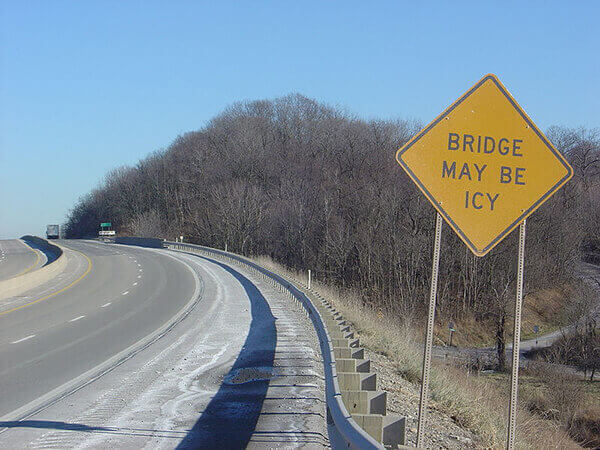Black Ice Danger
Black Ice, sometimes known as clear Ice, is a treacherous road condition that places drivers in a very dangerous situation with little or no warning. As with any form of ice, black Ice is very slippery and greatly reduces traction making it difficult to stop or turn. Generally, the ice forms when temperatures are below freezing (32°F or 0°C). However, in some cases it can form when the ambient temperature is well above freezing in cases where the air has warmed rapidly leaving the road surface still below freezing temperature. In conditions of very cold temperature (below 0°F or -18°C) ice can form on the road surface from the moisture created from car exhaust.
Due to the fact that black ice is a very think layer of ice, it can be very difficult to see, essentially "hiding" from the drivers perspective. When this occurs, drivers can be caught off guard, react in appropriately, and wind-up in a crash that could've been avoided. Black ice is very difficult to detect, but can often can be seen as a slightly darker spot on the roadway.

Sign often seen when approaching bridges
When the temperatures are at or below freezing, look for black ice in the following situations:
- In the shadows. As the Sun rises in the morning, trees can provide a shadow on the road making the road temperature several degrees colder than the road warmed by the sun. Under the right conditions, black ice can exist in these shadowy spots while the rest of the road is completely clear.
- Bridge overpasses. Most people have seen the road sign "Bridge May Be Icy" when approaching highway overpasses. When its below freezing, pay heed to this condition as ice will often form on bridge surfaces when the rest of the road is clear of ice. The change in traction on the bridge surface has caused many a driver to crash.
- Re-frozen water. During the day, temperatures can rise above freezing thus melting ice that has previously formed on roads. When the temperature drops back below freezing, often at night, this melted ice can re-freeze thus creating a thin sheen of ice on the road.
No matter how careful you are as a driver, it is not always possible to spot black ice and you can find yourself in a situation of reduced traction when least expected. Often, a treacherous driving situation is detected once a loss of traction occurs, for example the car starts to slide. Here are a few tips to keep in mind when driving in situations where black ice can occur:
- Slow down. It is obvious, but worth reiterating. In cold, wintry, conditions slower speeds make it easier to recover when faced with dangerous situations that can occur.
- When a car begins to loose traction, gradually slow down by easing your foot off the accelerator.
- Do not slam on the brakes as this will cause the vehicle to be even less stable. This is often the first reaction for most drivers, but resist the urge and gently apply the brakes.
- Keep the car headed in as straight a line as possible. The car will generally want to go straight naturally. The less turning you do when on black ice, the better. Once you're off the ice the car will gain traction immediately and continue in the direction the front tires are pointed.
The bottom line is that when driving in below freezing temperatures, keep an eye out for black ice. Following the above advice can reduce the likelihood of a crash.
